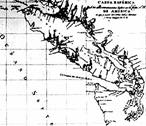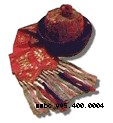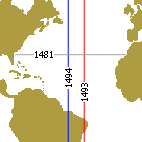
Spanish conquistador
helmet

Malaspina's chart
of Vancouver Island

Chinese sea otter hat
When explorers reached the North American continent they encountered groups of people that had lived there for thousands of years. Current theories suggest these first peoples arrived by traveling across the land bridge that once spanned the Bering Strait approximately 12,000 years ago.
| European exploration of North America began as early as the tenth century when Norse explorers such as Bjarni Herjulfsson, Eric the Red and his son Leif Erikson reached the east coast. It was not until the late 16th century that explorers such as Sir Francis Drake began to penetrate the Pacific Coast area of North America. | 
Spanish conquistador helmet |

Malaspina's chart of Vancouver Island |
By the 16th century the Spanish had made settlements in Peru and Mexico. Competing with English and Dutch attempts to find a northwest passage to Asia, the Spanish employed Juan de Fuca, a Greek navigator, to command an expedition that sailed north from Mexico seeking a northerly sea passage connecting the Pacific to the Atlantic. On this expedition, de Fuca discovered the strait between the mainland of British Columbia and Vancouver Island. |
| Explorers who followed, such as Vitus Bering (1741) and James Cook (1778), still searching for a northerly passage to Asia, realized the tremendous profits that could be had by developing a fur trade (mainly sea otter) with the First Nations peoples of the Northwest Coast. | 
Chinese sea otter hat |
News that survivors of the Bering expedition had sold sea otter pelts to Chinese traders for very high prices spread rapidly and Russian traders soon returned to trade for more pelts. In the 19th century, pelts were being sold in London at $300.00 apiece. | |
| The excerpt to the right is a journal entry of Captain James Cook F.R.S. dated Thursday, May 14th, 1778.
This passage probably refers to the West Coast chief Maquinna. |
Amongst those who came on board, was a good-looking middle-aged man whom we afterward found to be the Chief. He was clothed in a dress made of the sea-otter's skin; and had on his head such a cap as is worn by the people of King George's Sound (Nootka Sound), ornamented with sky-blue glass beads, about the size of a large pea. He seemed to set a much higher value upon these, than upon our white glass beads. Any sort of beads, however, appeared to be in high estimation with these people; and they readily gave whatever they had in exchange for them; even their fine sea-otter skins. But here I must observe, that they set no more value upon these than upon other skins, which was also the case at King George's Sound, till our people set a higher price upon them; and even after that, the natives of both places would sooner part with a dress made of these, than with one made of the skins of wild-cats or of martins. Second Edition, Volume II, 1785, pp. 357-58, Maritime Museum of British Columbia. | ||
This information inspired many Europeans and Americans to become involved in the sea otter trade. This trade became so popular during the 18th and 19th centuries, that by 1911 there existed only a mere 2000 sea otters in the entire Northwest Coast. In 1911 the sea otter became a protected species and has to this day made a slow but steady comeback.

| A Spanish expedition led by Estevan José Martinez and Lopez de Haro in 1788 confirmed Russian intentions to occupy Nootka Sound. This led to Spanish settlement in Nootka in 1789 to validate Spanish sovereignty to the west coast of North America. | |||

John Meares |
During this time (1788), John Meares, a British merchant heavily engaged in fur trade activities at Friendly Cove in Nootka Sound, built the first European vessel on the Northwest Coast, the Northwest America. This vessel was one of the British vessels later seized by Martinez as Spanish property, as a means of discouraging British trade and settlement in the area. | ||
| This incident aggravated tensions that already existed between the British and the Spanish, nearly resulting in war between the two countries. Instead, Spain ceded to Britain in 1790 after negotiations between British Commissioner George Vancouver and Spanish Commissioner Don Juan Francisco de Bodega y Quadra (then Governor of Nootka). This event has come to be known as the 'Nootka Convention'. | |||
| One may recall that the Spanish had similar problems with the the Portuguese at the dawn of new world exploration. |

Treaty of Tordesillas |
|
|
| Vancouver, who had already visited Nootka Sound as midshipman with Cook in 1778, began expeditions in 1792 to survey and chart the area which Juan de Fuca had discovered (Juan de Fuca Strait), which many believed would lead to a northwest passage. However, Vancouver discovered that the body of water which Juan de Fuca had sailed in did not lead to an eastward passage through North America; instead, it separated Quadra/Vancouver Island (what is known today as Vancouver Island) from the mainland. |

Vancouver's chart of Vancouver Island |
||
| Vancouver was able to explore this area effectively by using his vessels the Discovery and the Chatham as a base while operating smaller vessels such as a 'yawl', a 'cutter', and a 'longboat' to navigate around the maze of inlets, islands and channels. |

|
In these waters Vancouver met with Spanish explorers such as Dionisio Alcala Galiano, and, in a cooperative venture, shared and received information relating to exploration in this area. | |

![[English]](../simages/english.gif)
|

![[French]](../simages/french.gif)
|

![[Credits]](../simages/credit.gif)
|

![[Feedback]](../simages/feedback.gif)
|